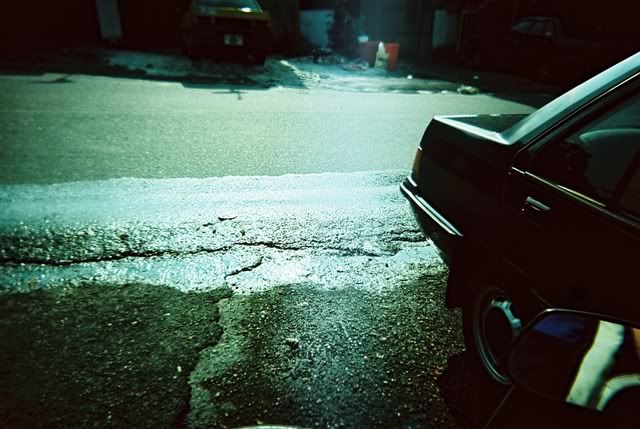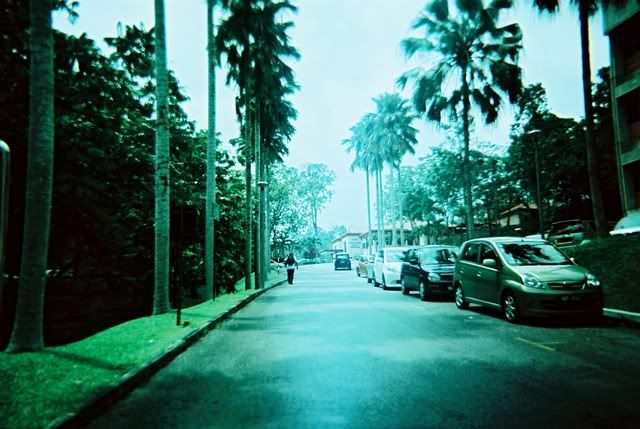Lomography and Cross Processing always been related to each other. Lomographers had been using cross processing technique to get the creative and 'WOW!!' factors out from their artworks. Cross processing (sometimes abbreviated to Xpro) is the procedure of deliberately processing photographic film in a chemical solution intended for a different type of film. The effect was discovered independently by many different photographers often by mistake in the days of C-22 and E-4...
It’s a beautiful thing actually. Simply put, you shoot a roll of film (most commonly slide film, or E-6) and develop it as if it were something different (most commonly color negative film, or C-41). Intentionally processing a film in the wrong chemicals. Doing this with slide film usually works out well. The results are very cool and C-41 processing is much more available than E-6...
Different Films Give Different Surprises...
Color cross processed photographs are often characterized by unnatural colors and high contrast. The results of cross processing differ from case to case, as the results are determined by many factors such as the make and type of the film used, the amount of light exposed onto the film and the chemical used to develop the film. The largest differences in the outcome of your cross processed photos have to do with the film you’re using. Each film has it’s own unique look, and they can vary drastically. The most obvious difference is the color cast produced during development. Here are some films type and their results after cross processed...
Kodak EktaChrome (or EliteChrome) = very green
Fujichrome Velvia 50 = green + some blue
Fujichrome Velvia 100 = very red + some magenta or yellow
Fujichrome Sensia 100 = red
Fujichrome Sensia 400 = blue + green
Fujichrome Provia 100 = green + yellow
Fujichrome Provia 400 = green + yellow
Konica Centuria 100 = little color cast
It’s worth noting that different developer solutions will have slightly different effects on the outcome of the film...
Looking For A Cross Processing Lab...
 Cross processing requires the C-41 process, and most of us aren’t equipped to do this ourselves. However, just about any lab that develops film will have this capability (since it’s the most common process for consumer/negative film). The tricky part is finding somebody who will cross process your E-6 film as C-41 film...
Cross processing requires the C-41 process, and most of us aren’t equipped to do this ourselves. However, just about any lab that develops film will have this capability (since it’s the most common process for consumer/negative film). The tricky part is finding somebody who will cross process your E-6 film as C-41 film...When film is developed, a lot of chemical reactions are taking place. The end result is a stable piece of film with an image on it and a bunch of extra stuff that gets left in the developer solution. Developing slide film in C-41 chemicals can leave behind stuff that normally isn’t left behind. So, developer solutions have to be changed out on a regular basis to continue to work properly. But, it does not do a great harm to the solution or to the other film being processed in the developer, but shops with less-experienced technicians will shy away from cross processing because of this...
Also, it is better to know the pricing of developing and printing of the film. Most photo lab will have similar pricing in developing and printing. But if you are not interested to print the photos, there is another option; scan the film. Scanning the film may costs you a small fortune but copying the digital images to the media storage (thumbdrive or CD) may have big differences in pricing between photo labs. It is better to ask few photo labs for their pricing before you regrets... :D
Digital Cross Processing...
 Cross processing effects can be simulated in digital photography by a number of techniques involving the manipulation of contrast/brightness, hue/saturation and curves in image editors such as Adobe Photoshop or GIMP. However, they lack the unpredictable nature of regular cross processed images. Some programs, such as online photo editer, Picnik even have a cross process function...
Cross processing effects can be simulated in digital photography by a number of techniques involving the manipulation of contrast/brightness, hue/saturation and curves in image editors such as Adobe Photoshop or GIMP. However, they lack the unpredictable nature of regular cross processed images. Some programs, such as online photo editer, Picnik even have a cross process function...All out of all, remember this:
- Processing positive color reversal film (slide film) in C-41 chemicals, resulting in a negative image on a colorless base.
- Processing negative color print film (negative film) in E-6 chemicals, resulting in a positive image but with the orange base of a normally processed color negative.
Have fun in cross processing... :D
Article source:
Epicedits.com
Wikipedia.com


No comments:
Post a Comment